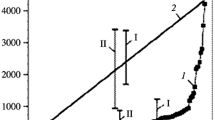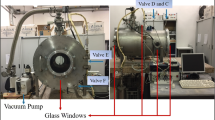Abstract
The Moments-algorithm was developed to post-process images of sprays with the aim of characterizing the sprays’ complex features (e.g., trajectory, dispersions and dynamics) in terms of simple curves, which can be used for developing correlation models and design tools. To achieve this objective, the algorithm calculates the first moments of pixel intensity values in instantaneous images of the spray to determine its center-of-gravity (CG) trajectory (i.e., the spray density-weighted centerline trajectory). Thereafter, the second moments (i.e., standard-deviations, σ) of intensities are calculated to describe the dispersion of spray materials around the CG. After the instantaneous CG's and σ's for the instantaneous images have been obtained, they are arithmetically averaged to produce the average spray trajectories and dispersions. Additionally, the second moments of instantaneous CG's are used to characterize the spray’s fluctuation magnitude. The Moments-algorithm has three main advantages over threshold-based edge-tracking and other conventional post-processing approaches: (1) It simultaneously describes the spray’s instantaneous and average trajectories, dispersions and fluctuations, instead of just the outer/inner-edges, (2) the use of moments to define these spray characteristics is more physically meaningful because they reflect the statistical distribution of droplets within the spray plume instead of relying on an artificially interpreted “edge”, and (3) the use of moments decreases the uncertainties of the post-processed results because moments are mathematically defined and do not depend upon user-adjustments/interpretations.


















Similar content being viewed by others
References
Abdou IE, Pratt WK (1979) Quantitative design and evaluation of enhancement/thresholding edge detectors. Proc IEEE 67:753–763. doi:10.1109/PROC.1979.11325
Barranco-Lopez V, Luque-Escamilla P, Martinez-Aroza J, Roman-Roldan R (1995) Entropic texture-edge detection for image segmentation. Electron Lett 31:867–869. doi:10.1049/el:19950598
Canny J (1986) A computational approach to edge detection. In: IEEE transactions on pattern analysis and machine intelligence, PAMI-8, pp 679–698. doi: 10.1109/TPAMI.1986.4767851
Claypoole R, Lewis J, Bhashyam S, Kelly K (2015) Laplacian edge detection. http://www.owlnet.rice.edu/~elec539/Projects97/morphjrks/laplacian.html. Accessed 18 August 2015
Gao W, Yang L, Zhang X, Liu H (2010) An improved Sobel edge detection. IEEE 9:67–71. doi:10.1109/ICCSIT.2010.5563693
Gopala Y, Zhang P, Bibik O, Lubarsky E, Zinn BT (2010) Liquid fuel jet in crossflow- trajectory correlations based on the column breakup point. In: 48th AIAA aerospace sciences meeting including the new horizons forum and aerospace exposition, AIAA, p 214
Greensted A (2015) Otsu thresholding. The lab book pages: an online collection of electronics information. http://www.labbookpages.co.uk/software/imgProc/otsuThreshold.html. Accessed 28 May 2015
Hajialimohammadi A, Abdullah A, AghaMirsalim M, Chitsaz I (2009) Experimental and numerical investigation of spray formation of gaseous direct injector. J Mech Sci Technol 23:1261–1269
Leong MY, McDonell VG, Samuelsen GS (2001) Effect of ambient pressure on an airblast spray injected into a crossflow. J Propuls Power 17:1076–1084
Li LKB, Green SI, Davy MH, Eadie DT (2010) Viscoelastic air-blast sprays in a cross-flow. Part 1: penetration and dispersion. At Sprays 20:697–720. doi:10.1615/AtomizSpr.v20.i8.30
Lin J (1995) Divergence measures based on Shannon entropy. IEEE Trans Inf Theory 37:867–869. doi:10.1109/18.61115
Lubarsky E, Shcherbik D, Bibik O, Gopala Y, Zinn BT (2012) Fuel jet in cross flow- experimental study of spray characteristics. In: Oh HW (ed) Advanced fluid dynamics. InTech, Croatia
Mongia HC (2003) TAPS- a 4th generation propulsion combustor technology for low emissions. In: AIAA/ICAS International Air and Space Symposium and Exposition: The Next 100 Y, AIAA, p 2657
Myers WJ Jr, Mancini AA, Hsiao GCC, Li SC, Hsieh SY, Mongia HC (2013) Method and apparatus for actively controlling fuel flow to a mixer assembly of a gas turbine engine combustor. US 8,607,575 B2, 17 Dec 2013
Pastor JV, Arregle J, Palomares A (2001) Diesel spray image segmentation with a likelihood ratio test. Appl Opt 40:2876–2885. doi:10.1364/AO.40.002876
Prewitt JMS (1970) Object enhancement and extraction. In: Lipkin B, Rosenfeld A (eds) Picture processing and psychopictorics. Academic, New York, pp 75–149
Shahangian N, Honnery D, Ghojel J (2012) Homogenisation of high pressure diesel fuel spray combustion using porous ceramic media. In: ASME 2012 internal combustion engine division fall technical conference
Sobel I (2014) History and definition of the Sobel operator. ResearchGate. http://www.researchgate.net/publication/210198558_Feldman_G._A_3x3_isotropic_gradient_operator_for_image_processing
Tan ZP, Lubarsky E, Bibik O, Shcherbik D, Zinn BT (2014) Application of planar laser-induced phosphorescence to investigate jet-A injection into a cross-flow of hot air. In: Proceedings of ASME Turbo Expo 2014: Turbine Technical Conference and Exposition, GT2014-25661
Tan ZP, Lubarsky E, Bibik O, Shcherbik D, Zinn BT (2016) The effects of air-assist upon liquid fuel jet penetration and dispersion in a cross-flow of pre-heated air. At Sprays. doi:10.1615/AtomizSpr.013586
Yates CL (1972) Liquid injection into a supersonic stream. AFAPL-TR-71-97, 1
Acknowledgments
We would like to thank Dr. Nayan Patel and Dr. Michael Benjamin from GE-Aviation for their long-term support of the jet-in-cross-flow research at the Ben T. Zinn Combustion Laboratory.
Author information
Authors and Affiliations
Corresponding author
Rights and permissions
About this article
Cite this article
Tan, Z.P., Zinn, B.T., Lubarsky, E. et al. A moments-based algorithm for optimizing the information mined in post-processing spray images. Exp Fluids 57, 19 (2016). https://doi.org/10.1007/s00348-015-2102-8
Received:
Revised:
Accepted:
Published:
DOI: https://doi.org/10.1007/s00348-015-2102-8




